Understanding the Prone Foil Board Dynamics
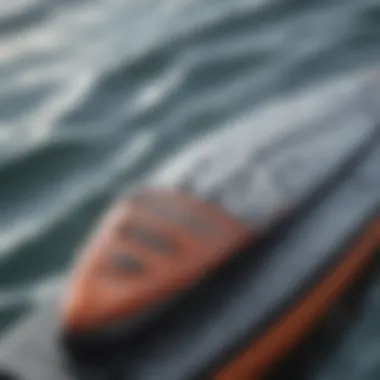
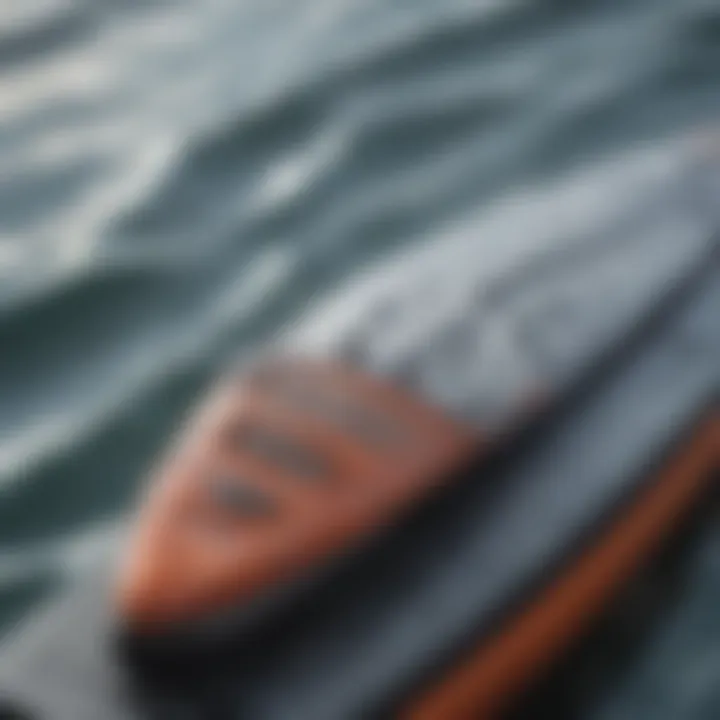
Intro
The evolution of watersports has introduced a variety of new and exciting equipment that enables enthusiasts to experience the thrill of gliding across water in a whole new manner. One such innovative creation is the prone foil board. Not merely a toy for the adventurous, this piece of equipment is making waves—quite literally—in the watersports community. The unique design and functionality of prone foil boards present both opportunities and challenges that range from mastering the techniques to selecting the right gear.
Grasping the intricacies of prone foil boarding isn't just about hopping on board and chasing the wind. It involves a thoughtful approach to technique, a thorough understanding of equipment, and consistent practice. With that in mind, this exploration will delve into the crucial skills and techniques necessary for those just beginning their journey, as well as advanced methods for seasoned athletes.
In this article, readers will also uncover various aspects of the equipment involved, including essential gear that complements the prone foil boarding experience. Whether you're an experienced rider looking to polish your skills or a newcomer eager to learn the ropes, there's something to gain from this comprehensive examination of an emerging sport.
Let's dive deeper into the Techniques and Skills that can take your prone foil boarding experience from basic to exhilarating.
Foreword to Prone Foil Boarding
The thrill of riding a wave is an age-old passion, one that finds new expression in prone foil boarding. This section introduces the essence of prone foil boarding, a unique blend of athletic skill and innovative technology. Understanding what it entails not only serves to bridge the gap for newcomers but also enriches the experience for seasoned riders. In the world of watersports, prone foil boarding stands out due to its capacity to unleash adrenaline while promoting synergy with nature.
Defining Prone Foil Boarding
Prone foil boarding can be defined as riding a specialized surfboard affixed with a hydrofoil beneath it. This setup allows the board and rider to glide above the water's surface as the foil generates lift through hydrodynamic forces. The rider typically adopts a prone position, which is akin to lying down, using paddling techniques to get into position and to control movement. This unique stance is what differentiates prone foil boarding from other water-based activities, such as conventional surfing or SUP boarding.
In essence, prone foil boarding combines elements of surfing with the science of physics. Riders can maneuver smoothly across the water, utilizing both their body weight and the board’s design to maintain stability and speed. The innovation here involves not just how the riders balance and steer but also how they interact with the water beneath them.
Historical Evolution of Prone Foil Boards
To grasp the current capabilities of prone foil boards, it's essential to look back at their evolution. The roots of this sport can be traced to both surfing and traditional foil boarding, which took shape in the mid-20th century. Foils themselves were pioneered for use in various nautical wellness before making their way to recreational watersports.
The timeline of prone foil boarding reflects a growing interest in maximizing efficiency and speed in water sports. Early adopters of the technology experimented with modified surfboards that were equipped with lifted foils. The beauty of this evolution is in its grassroots nature—enthusiasts from various backgrounds started to improvise, leading to significant innovation.
Today, companies like Slingshot and GoFoil contribute to advanced designs that not only improve performance but also boost safety. As riders became more drawn to the excitement of foiling in different types of water conditions, the sport began to gain traction, leading to communities dedicated solely to prone foil boarding.
For many, prone foil boarding represents more than just a hobby. It is an ongoing journey of discovery, excitement, and connection with the ocean. This overview sets the stage for a deeper exploration of the mechanics, techniques, and overall significance of prone foil boarding in today’s aquatic sports landscape.
The Mechanics of Prone Foil Boards
The mechanics behind prone foil boards play a pivotal role in their functionality and performance. Understanding these mechanics helps in grasping how these boards work seamlessly with the environment, allowing an exhilarating experience on the water. It's more than just paddling; it’s about finesse, balance, and a deep connection with the ocean.
Anatomy of the Foil Board
Board Construction Materials
The construction of a prone foil board often involves a blend of materials like fiberglass, carbon fiber, and sometimes wooden cores. Each material uniquely contributes to the overall durability and performance. For instance, carbon fiber is notably strong yet lightweight, making it a preferred option for performance-focused boards.
This material helps in achieving higher speeds while maintaining agility. Additionally, the lightness aids beginners in managing their board better, which is crucial in early learning stages. However, it can come at a steep price, so depending on one’s budget, other options such as fiberglass might also be appealing, albeit a bit heavier.
Foil Design Principles
Foil design is central to a board's ability to lift and glide above the water's surface. The shape and size of the foil can greatly affect performance. For riders seeking speed, a longer, thinner foil is often ideal, whereas wider foils can provide better lift at lower speeds.
This balance of design is essential because if the foil is not designed well, it can lead to instability or reduced efficiency in the water. One unique feature seen in some boards are adjustable foils, allowing riders to adapt based on conditions or skill. However, these adjustable systems may introduce complexities that newer users might find challenging.
Weight Distribution and Stability
Correct weight distribution on a prone foil board enhances stability, which is crucial during maneuvers and high speeds. Boards are typically engineered to allow riders to position themselves correctly, influencing how weight shifts when paddling or catching waves.
The key characteristic here is the center of gravity. Boards designed with a lower center of gravity can provide better stability, which is particularly beneficial for novices still grappling with balance. A disadvantage, however, might be reduced speed if the board is too heavy on one side, causing unnecessary drag.
How Foils Create Lift
Hydrodynamic Forces
Hydrodynamics, the study of fluids in motion, is fundamental to understanding how a foil board stays afloat. When a foil moves through the water, it interacts with water currents creating forces that lift the board. The design of the foil influences these forces significantly.
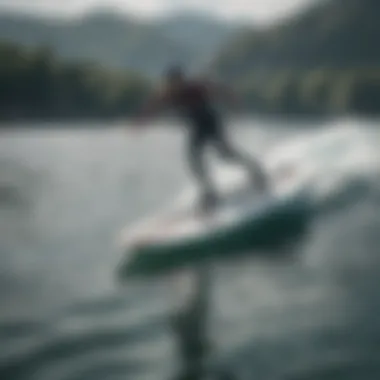
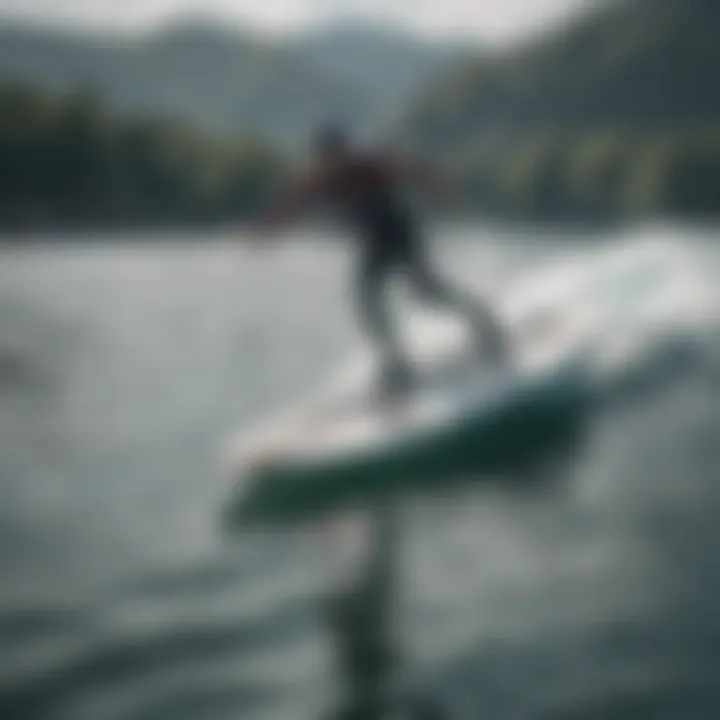
The primary advantage here is that effective hydrodynamics can lead to increased speeds with less effort, as well as prolonged rides with energy conservation. However, if not designed correctly, foils can create excessive turbulence, leading to instability and potential spills.
Angle of Attack
The angle at which a foil meets the water is known as the angle of attack, and it’s crucial for generating lift. Too steep an angle can cause the board to stall, while too shallow can diminish its lift capability. Finding that sweet spot is essential for every rider, especially when conditions change.
A key benefit is the versatility offered by adjustable angles, allowing riders to modify depending on their skill and the surf conditions. But maintaining accuracy in adjusting this angle can be another hurdle for those just starting out.
Water Flow Dynamics
Water flow dynamics explore how water moves around the foil as it glides. Understanding these dynamics aids riders in predicting how the board will react in various conditions. When the water flows in a streamlined manner around the foil, nearly negligible resistance allows them to achieve better performance.
The movement of water can be influenced by many factors, such as wave size and speed. Thus, a thorough understanding of these factors can end up being the difference between a smooth ride and a rough tumble. It's both an art and science that requires practice to master, but the rewards are hard to beat.
In summary, the mechanics of prone foil boards entail complex interactions between design and user dynamics, leading to a unique riding experience that is ever-evolving.
Advantages of Using Prone Foil Boards
Prone foil boarding, which has garnered attention in recent years, offers a plethora of advantages that make it a sought-after activity for ocean enthusiasts. The unique characteristics of this sport cater to a range of riders, from those who thrive on speed to those simply seeking a new adventure on the water. Let's explore the key benefits of using prone foil boards in detail.
Enhanced Speed and Efficiency
One of the standout attributes of prone foil boarding is its ability to achieve remarkable speed. With the foil's design enabling the board to ride above the water's surface, drag is significantly reduced compared to traditional surfing or paddling. When the rider positions themselves correctly, even small waves can inflate their speed with ease.
Catching waves and maintaining momentum becomes effortless, allowing users to cover more distance without expending excessive energy. This efficiency is attractive for those who enjoy long sessions on the water. Plenty of experienced riders echo this sentiment, explaining how the transition from traditional boards to foil boards has resulted in better performance and longer outings.
"Once you get the hang of it, the glide feels almost magical," notes a seasoned prone foil boarder, emphasizing the exhilarating experience of riding above choppy waters.
Unique Riding Experience
The experience of using a prone foil board stands apart from conventional watercraft. The sensation of riding high above the waves provides not only a thrilling experience but also a unique connection with the ocean. As the board lifts, riders can observe the underwater aquatic life, making one feel like they are gliding on the water rather than simply surfing it.
Additionally, the learning curve associated with prone foil boarding offers a rewarding challenge. Novices quickly discover the joy of mastering balance and control, while seasoned riders can push their skills further, experimenting with advanced moves and tricks. This constant opportunity for growth ensures that riders remain engaged long after their initial experiences.
Impact on Ocean Conservation
Surprisingly, prone foil boards contribute positively to ocean conservation. Because foiling allows users to travel longer distances with less energy, there's a reduced need for motorized support boats or jet skis, which typically disturb marine habitats. With less reliance on power-driven watercraft, there can be a decrease in pollution and damage to delicate ecosystems.
Both individual riders and brands are becoming more aware of their environmental footprint. Many manufacturers, like GoFoil and Lift Foils, are focusing on sustainable practices and materials in their production processes. This shift toward eco-friendly manufacturing resonates particularly well with those who are passionate about preserving the oceans. The blend of adventure and conservation reflects a growing trend among sports enthusiasts who are not only seeking thrill but also want to protect the landscapes they enjoy.
Challenges Associated with Prone Foil Boarding
Prone foil boarding, while exhilarating, also brings along its fair share of challenges. Understanding these obstacles is pivotal for both new and seasoned riders as it allows them to prepare adequately and thus enhance their overall experience on the water. From skill development to safety considerations, recognizing these nuances is key. Knowing what to expect helps create a more enjoyable and informed journey into this sport.
Learning Curve and Skill Development
Common Mistakes Beginners Make
Many newcomers jump right into prone foil boarding without realizing the learning curve involved. One prevalent mistake is underestimating the importance of body positioning. For instance, some beginners tend to keep their bodies too rigid. This rigidity can prevent them from properly leveraging the board's buoyancy and lift, leading to unnecessary falls and frustration. Understanding how shifting weight can change the way the foil interacts with the water is a vital lesson.
Another common blunder is neglecting to calibrate the angle of attack correctly. Many riders approach the foil with an aggressive tilt, thinking it would produce more speed. However, too steep an angle can result in a nosedive, catapulting the rider into the water—a rather uncomfortable experience.
This section is significant because it sets the foundation for new riders. By addressing these mistakes early on, beginners can focus on effective strategies rather than constantly correcting their form. Moreover, acknowledging these pitfalls fosters a more cautious and aware community of riders, encouraging shared experiences and learning opportunities.
Strategies for Skill Improvement
Improving one's skills in prone foil boarding entails a blend of practice and education. One highly suggested strategy is to take lessons from an experienced instructor. Personal guidance from a seasoned practitioner can accelerate learning and refine techniques faster than solo practice. An instructor can point out subtle mistakes that may not be apparent to untrained eyes, helping students progress from beginner to proficient more rapidly.
Additionally, practicing in controlled water conditions, such as flat seas or smaller waves, enables riders to hone their skills without the added pressure of challenging elements. This environment permits riders to focus solely on technique and build confidence gradually.
Sharing progress on platforms like Reddit may also provide insights and encouragement. Engaging with a community can yield tips on overcoming specific challenges and reinforce the camaraderie that comes with pursuing a new sport. These strategies are essential as they not only enhance technical skills but also build a supportive athletic culture.
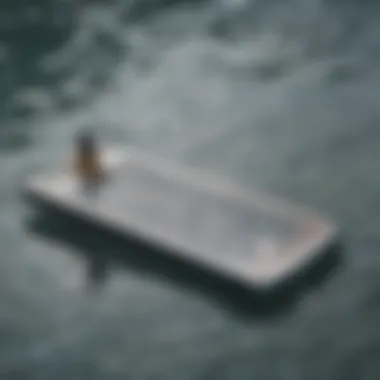
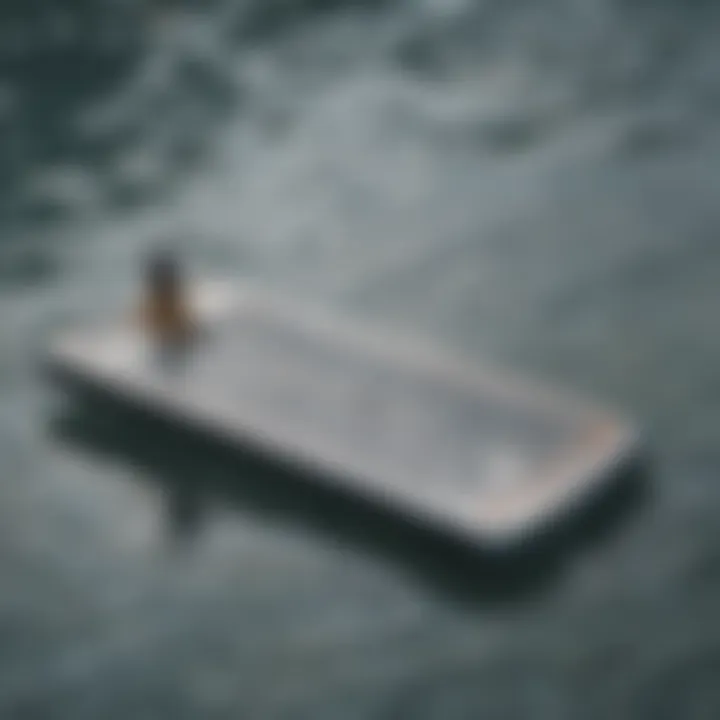
Safety Considerations
Understanding Water Conditions
One can't emphasize enough the significance of comprehending water conditions when engaging in prone foil boarding. Factors such as currents, tidal changes, and wave heights play a critical role in determining a safe riding environment. Riders unfamiliar with local waters may misjudge conditions and dive in, leading to dangerous situations.
What's particularly beneficial about having a sound understanding of these conditions is the ability to anticipate and react to environmental changes. Knowing when and where to ride can help prevent accidents, ensuring that the thrill of the activity doesn't come with undue risks. It might not seem glamorous, but a bit of research on local tides and weather can make all the difference—noting how conditions fluctuate during the day can save a lot of trouble.
Personal Protective Equipment
Using proper personal protective equipment (PPE) in prone foil boarding is not just a recommendation; it's a necessity. Items like helmets, impact vests, and even appropriate footwear can significantly minimize the risk of injury. Riders should be mindful of the fact that accidents occur, and being prepared is the best way to mitigate potential harm.
The unique feature of PPE is that it provides a layer of protection without hindering performance. For example, a well-fitted helmet can protect against impacts while allowing the rider to maintain full mobility. The right buoyancy aid can provide extra support without restricting movement, giving comfort while out on the water.
Techniques for Effective Prone Foil Boarding
Mastering techniques for effective prone foil boarding is indispensable for riders hoping to harness the full potential of this unique watersport. Unlike conventional surfing, which relies heavily on wave power, prone foil boarding emphasizes balance, control, and precision. The interplay between the board, the rider, and the water creates a symbiotic relationship that, when well understood, greatly enhances performance and enjoyment on the water.
Paddling Techniques
Paddling is not merely a means to get from point A to point B when prone foil boarding; it is the lifeline that connects a rider to the water's surface. Good paddling techniques directly influence a rider's ability to catch waves and generate lift. Here are crucial aspects to focus on:
- Timing is Everything: As waves approach, the timing of paddling becomes critical. Start paddling at the correct moment—just before the wave starts to lift your board. This allows the board to catch the wave efficiently without getting caught in the backwash.
- Body Positioning: Laying flat with your body distributed evenly across the board helps in reducing drag. Keep your head low and your limbs tight to minimize resistance against water flow. Positioning your chest just above the nose of the board tends to work well for balance.
- Arm Technique: Your arms should alternate and paddle in a circular motion, resembling a windmill. Dipping your hands deep into the water ensures maximum propulsion without causing fatigue.
**"Proper paddling technique is as crucial as a quarterback’s throw; both can make or break the play."
Achieving Lift and Control
Creating lift while maintaining control is akin to walking a tightrope; it requires balance, timing, and awareness of the dynamic forces at play. To achieve this, consider the following:
- Hydrodynamic Awareness: Understanding how hydrodynamics work, particularly with respect to the foil's angle of attack, is crucial. The angle at which the foil meets the water directly impacts lift. A higher angle can provide more lift, but too much can lead to instability.
- Weight Distribution: Your center of gravity plays a pivotal role. Shifting your weight slightly forward encourages lift, while leaning back can prevent nose-diving. Experiment with slight movements of your hips and shoulders to find that sweet spot.
- Using Boat Waves: If you’re in a crowded area and the conditions are flat, consider using boat wakes to generate lift. Position yourself strategically and use their energy to help lift the board out of the water, allowing for a smoother ride.
Transitioning Between Moves
Perhaps one of the most exhilarating parts of prone foil boarding is the transition between moves. As with any sports discipline, smooth transitions can often set apart the amateurs from seasoned riders. Here’s how to approach this:
- Fluidity is Key: When moving from a paddling stance to a standing position, maintain a fluid motion to avoid disruption to your center of balance. Slow, deliberate shifts are more effective than abrupt movements.
- Prepping for the Next Move: Always be attuned to the water's texture and flow. If you're preparing to switch from riding a wave to performing a trick, begin shifting your weight in anticipation. This proactive approach pays off during those critical moments.
- Consistency in Practice: Like anything else, mastering transitions comes with consistent practice. Set aside time in each session to deliberately focus on shifting between moves, gradually increasing speed as you gain confidence.
Each of these techniques is an integral part of developing a comprehensive skillset for prone foil boarding. The nuances will emerge with experience, but understanding the foundations will pave the way for greater mastery over this thrilling sport.
Choosing the Right Prone Foil Board
Selecting the perfect prone foil board truly influences not only how well you perform but also your enjoyment on the water. The wrong choice can lead to frustration and limit your ability to progress, while the right board can unlock potential you didn’t even know you had. Thus, it’s essential to consider various factors that can enhance your experience.
Factors to Consider When Selecting a Board
Skill Level
Your skill level plays a significant role in determining which board is best suited for you. Beginners often benefit from a more stable and forgiving board that allows for easier balancing while getting used to the foil's lift. A board designed for entry-level riders usually features wider dimensions, offering better stability and making it easier to paddle and stay afloat.
For those more experienced, a smaller, lighter board can provide greater agility and speed but might come at the cost of stability. Essentially, matching your skill level with the right board provides the foundation needed to confidently navigate the water. Mistakes in this regard can lead to unnecessary challenges as you hone your technique.
Conditions and Environment
The conditions of the water where you plan to ride must not be ignored. Riding in offshore winds, choppy surf, or calm water all dictate different board requirements. A board with a more pronounced hull might perform better in choppier waters, providing a steadier ride. On the other hand, a flatter board could excel in smoother, calmer conditions — allowing you to maximize speed and control.
Weather conditions like waves and wind also impact your choice. For example, if you're often riding in small beach breaks, you might opt for a board meant to navigate varied conditions effectively. The right selection helps tailor your experience, ensuring that both your sessions and skill progression are enjoyable.
Board Dimensions
Dimensions are often overlooked, yet they substantially affect your performance. Generally, longer boards provide better tracking and are suited for larger riders, but they might be clumsier in tight turns. A shorter board can offer better maneuverability, which is essential for performing tricks but may require more consistent technique to ride effectively.
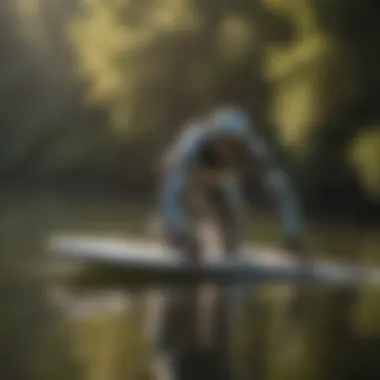
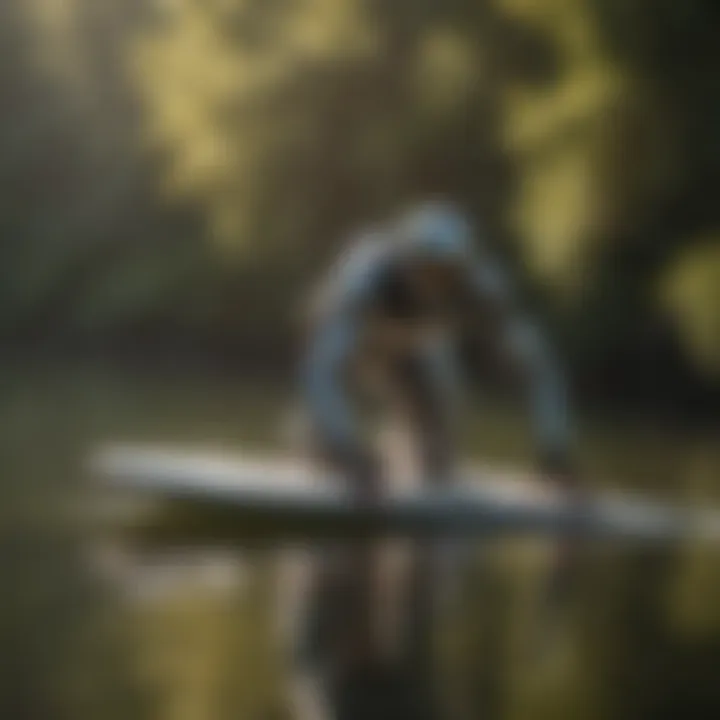
Width is also a factor; a wider board gives increased stability, making it easier to balance, particularly for novices. If you’re searching for versatility, consider a mid-size board that balances both length and width for different riding styles. Choosing the right dimensions ensures you capitalize on your skills while remaining comfortable and secure on the water.
Popular Brands and Models
With a large array of brands and models flooding the market, it can be a challenge to determine which ones stand out. Look for established brands known for their quality and performance. Names like GoFoil, Armstrong Foils, and Slingshot are recognized for their innovations and reliability.
It’s wise to seek reviews from fellow riders or forums, like reddit.com, where user experiences are shared openly. Understanding customer feedback helps navigate your purchase decision towards products that align with your riding style and preferences.
Maintenance of Prone Foil Boards
Maintaining a prone foil board is not just about keeping it shiny; it is crucial for its performance, longevity, and your safety while riding. With the right care, these boards can thrive through countless sessions on the water, ensuring you enjoy the sport to its fullest without worrying about equipment failures. Regular maintenance can ultimately save you both time and money down the line, allowing you to focus more on honing your skills in the waves.
Cleaning and Care Tips
Keeping your prone foil board clean is essential. The ocean can be harsh, and contaminants like salt, sand, and dirt can wear down your board over time. Here are steps to ensure your board stays in top shape:
- Rinse After Each Use: A simple rinse with fresh water can make a world of difference. This helps to remove salt, which can corrode your board and foil components.
- Gentle Soap Application: If your board is particularly grimy, use a mild soap with a soft sponge. Scrubbing too hard can scratch the surface, so be gentle.
- Dry Thoroughly: After rinsing, dry your board completely. Storing it wet can lead to mold and mildew issues, especially in the padding and straps.
- Inspect for Damage: Each cleaning session is a good opportunity to check for chips, cracks, or other signs of wear. Catching these issues early can prevent more serious damage down the line.
"A clean board not only looks good but performs better and lasts longer."
Repair and Damage Prevention
No matter how careful you are, accidents can happen. Therefore, knowing how to repair and prevent damage to your prone foil board is key. Here are some essential tips:
- Use Protective Gear: Invest in a padded bag for transportation. This will protect your board from bumps and scrapes during transit.
- Ding Repair Kits: Keep a repair kit handy for minor scratches or dings. These kits usually include resin and fiberglass materials that can be easily applied after sanding down the damaged area.
- Avoid Rough Surfaces: Be mindful when launching and landing. Avoid dragging your board on coarse surfaces that can cause abrasions.
- Foil Maintenance: Don't forget about the foil! Regularly check the connections and ensure everything is secure. Loose components can lead to accidents or damage.
By prioritizing these maintenance practices, you not only enhance the longevity of your prone foil board but also ensure a safer and more enjoyable riding experience. Remember, a well-maintained board is your best ally in the pursuit of mastering the waves.
The Future of Prone Foil Boarding
As we look ahead, the realm of prone foil boarding stands on the precipice of transformation. The importance of this topic cannot be overstated, given the sport's rapid evolution. New technologies and designs are emerging daily, creating exciting opportunities for enthusiasts. With advancements in materials and equipment, we’re not just enhancing performance but also making this adventure more accessible to a wider audience.
Innovations in Design and Technology
The landscape of prone foil boards is changing at a breakneck pace. These innovations are not merely enhancements; they're redefining the experience on the water. Here are a few key elements shaping this future:
- Lightweight Materials: The shift to carbon fiber and other advanced composites is significant. These materials offer strength without the bulk, resulting in boards that are easier to maneuver and paddle.
- Improved Hydrofoil Designs: New foil shapes and sizes are being tested, allowing for better lift and stability. This improvement in lift not only enhances speed but also encourages longer periods of flight above the water's surface.
- Smart Technology Integration: Imagine integrating GPS, speed sensors, or even heart rate monitors into a prone foil board. These technologies can provide real-time feedback to the user, improving technique and safety.
As these innovations roll out, they promise to attract not just seasoned pros but also newcomers eager to dive into this thrilling sport.
Growing Community and Events
Alongside technological advancements, the growing community around prone foil boarding cannot be overlooked. The popularity of the sport has surged, leading to a robust network of enthusiasts ranging from casual riders to serious athletes. Events centered on prone foil boarding are popping up worldwide, encouraging camaraderie and competition.
- Races and Competitions: Organized events, such as local races or international contests, are gaining traction. These competitions are not just about winning; they foster a spirit of community, bringing riders together to share techniques and experiences.
- Workshops and Training Camps: With the increase in participants, workshops are cropping up, focusing on skill enhancement. Instructors are keen to teach enthusiasts, allowing them to master the art of prone foil boarding in a supportive environment.
- Online and Offline Communities: Forums on platforms like Reddit and Facebook are buzzing with discussions, tips, and experiences. This blend of virtual and physical communities makes it easier for newcomers to find guidance and encouragement from seasoned riders.
The excitement surrounding prone foil boarding is palpable. With technological innovations and an active community supporting its growth, the future looks bright for those ready to take the plunge.
Culmination
The conclusion of this article encapsulates the essence of prone foil boarding, offering insights rooted in both the sport itself and its broader implications within the realm of water sports. As we have seen, prone foil boarding isn’t just about gliding over water; it’s a convergence of skill, design innovation, and environmental awareness.
Summarizing Key Insights
Throughout this exploration, we touched on several critical points:
- The Mechanics and Design: Understanding the anatomy of a prone foil board is paramount. From the board construction materials to the specific design principles of the foil, each detail plays a significant role in performance.
- Benefits and Unique Experiences: The advantages of using prone foil boards extend far beyond mere speed. This sport provides a thrilling experience, characterized by a unique perspective of the ocean and an intimate connection with nature.
- Challenges and Safety: For all its allure, prone foil boarding comes with its fair share of challenges. Recognizing common beginner mistakes, and prioritizing safety through proper equipment and an understanding of water conditions, can lead to a more enjoyable experience.
- Future Prospects: As technology advances, so does the sport itself. Innovations in board design and a growing community are driving newfound enthusiasm and participation in prone foil boarding.
Each of these elements contributes to a holistic understanding and appreciation of prone foil boarding. We have peeled back layers to show both the technical and experiential aspects, forming a well-rounded narrative that aims to empower enthusiasts.
Encouragement for Enthusiasts to Engage
For those eager to dive into prone foil boarding—or perhaps those just beginning their journey—now is the time to engage more deeply with this exhilarating sport. Whether it’s joining local clubs or participating in events, community involvement can significantly enhance the learning curve. Social platforms like Reddit can provide support and advice from experienced riders, while also keeping you updated on latest trends.
Consider sharing experiences and tips with others, as such interactions not only enrich your knowledge but also foster camaraderie within the community. Plus, attending workshops or instructional sessions can bolster your skills, providing structured guidance as you navigate through the initial hurdles.
Ultimately, prone foil boarding offers an opportunity to escape the ordinary, to connect with the waves, and to experience the ocean in a truly unique manner. So grab your gear, head out to the water, and let the thrill of prone foil boarding sweep you off your feet.







